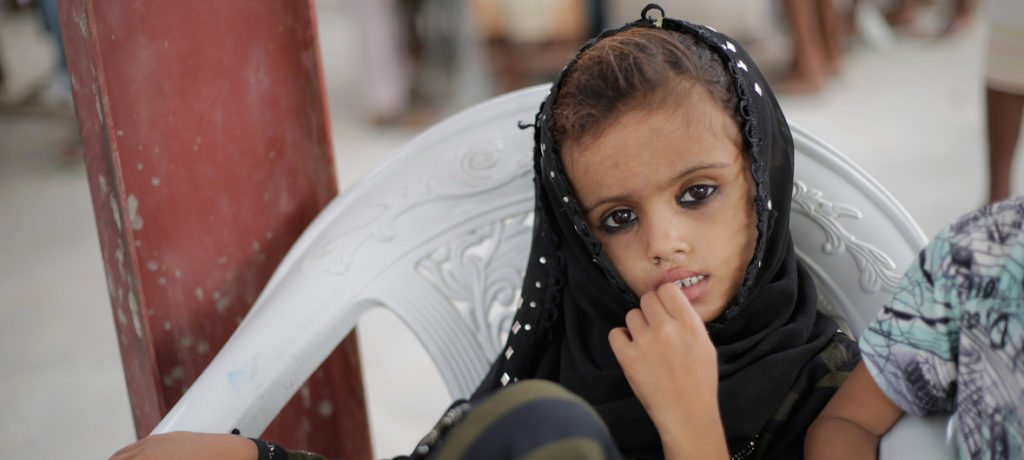Yemen: Tackling The World’s Largest Humanitarian Crisis
UNITED NATIONS, 1 Oct 2018
UN News – TRANSCEND Media Service
With three-quarters of the population requiring some form of basic assistance to survive, the humanitarian crisis in Yemen, now in its fourth year, has reached unprecedented levels of need. Today, ahead of the United Nation’s 73rd General Assembly high-level debate, a special event will focus on the humanitarian response across the country, its major achievements and its daily challenges, in an attempt to galvanize more international support.
24 Sep 2018 – The figures of the crisis are staggering and near-impossible to grasp: 22.2 million in need of assistance, 8.4 million people severely food insecure, and a further 10 million that could fall under the same category by the end of the year, if action is not urgently taken.“It is bleak”, UN humanitarian chief Mark Lowcock told the Security Council on Friday. “We are losing the fight against famine”.
In addition, more than 1.1 million cases of acute watery diarrhoea or cholera have been reported since April 2017.
Conflict in Yemen – already one of the poorest countries in the world before the crisis – escalated in March 2015, when an international coalition led by Saudi Arabia intervened militarily at the request of the Yemeni President. Airstrikes have become a daily occurrence for millions of civilians.
Since 1 June alone, according to the UN Office for the Coordination of Humanitarian Affairs (OCHA), half a million people have been forced to flee their homes in Hudaydah, an opposition-held governorate in western Yemen, bringing the total of internally displaced persons in the country to 2 million.
Hundreds of thousands of families no longer have a regular source of income – including teachers, health workers, water and sanitation workers and other public servants. They have not been paid a regular salary in two years.
Currently, over 150 relief organisations, including eight UN agencies, are working around the clock to provide food, shelter, nutritional assistance, protection services and much more to millions of Yemenis whose lives have been uprooted by the conflict.

A child waits as UNICEF-supported emergency humanitarian supplies are distributed in Hudaydah, Yemen in June 2018. © UNICEF
Of the nearly US$ 3 billion required for this year’s response plan, $2 billion (65 per cent) have been mobilized, making it the world’s best funded humanitarian appeal. The humanitarian response reaches more than 7 million people every month across Yemen and the number of people reached has increased consistently across sectors during the year.
However, the needs continue to outpace the response capacity and humanitarian workers face critical challenges every day. According to OCHA, the organizer of the General Assembly high level event, these include impediments to humanitarian action such as movement restrictions, attempted interference and harassment, as well as fluctuating commercial import levels and collapsing basic health, education, water and sanitation services.
The event will take place from 1:15 pm to 2:30 pm at UN Headquarters and will be broadcast live on webtv.un.org. It will include opening remarks by the UN head of humanitarian affairs, Mr. Lowcock, and a briefing by Yemen’s Resident and Humanitarian Coordinator for the UN, Lise Grande.
DISCLAIMER: The statements, views and opinions expressed in pieces republished here are solely those of the authors and do not necessarily represent those of TMS. In accordance with title 17 U.S.C. section 107, this material is distributed without profit to those who have expressed a prior interest in receiving the included information for research and educational purposes. TMS has no affiliation whatsoever with the originator of this article nor is TMS endorsed or sponsored by the originator. “GO TO ORIGINAL” links are provided as a convenience to our readers and allow for verification of authenticity. However, as originating pages are often updated by their originating host sites, the versions posted may not match the versions our readers view when clicking the “GO TO ORIGINAL” links. This site contains copyrighted material the use of which has not always been specifically authorized by the copyright owner. We are making such material available in our efforts to advance understanding of environmental, political, human rights, economic, democracy, scientific, and social justice issues, etc. We believe this constitutes a ‘fair use’ of any such copyrighted material as provided for in section 107 of the US Copyright Law. In accordance with Title 17 U.S.C. Section 107, the material on this site is distributed without profit to those who have expressed a prior interest in receiving the included information for research and educational purposes. For more information go to: http://www.law.cornell.edu/uscode/17/107.shtml. If you wish to use copyrighted material from this site for purposes of your own that go beyond ‘fair use’, you must obtain permission from the copyright owner.